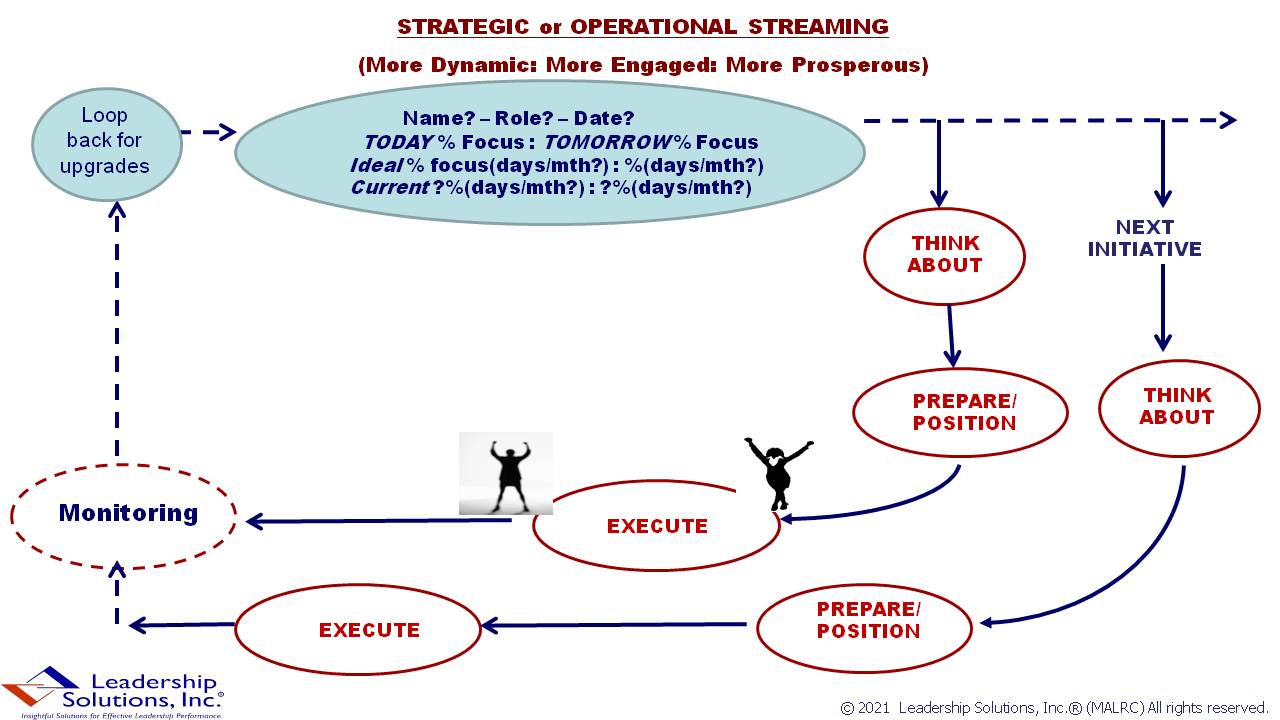by Peter A. Arthur-Smith, Leadership Solutions, Inc
“Research in neuroscience tells us that the brain doesn’t really do tasks simultaneously, as we thought (hoped) it might. In fact, we just switch tasks quickly.” Article by Nancy K. Napier, PhD, entitled ‘Creativity without Borders’ in journal Psychology Today, dated May 12th, 2014

In line with our opening quote, it sounds like the enlightened leader’s (EL’s) approach is multi-tasking although we’ll demonstrate that is not the case. Many multi-taskers do not understand that their approach is very stressful and can lead to burnout over time. They often don’t understand how disruptive and ineffective their approach can be. That’s where an enlightened leader’s approach of Strategic or Operational Streaming comes into its own. One big difference between conventional management (CM) and enlightened leadership (EL) is their divergent capabilities in moving forward and creating momentum. This is one key reason why genuine leadership wins out over time. CMs are inclined to take a logical, step-by-step approach, whereas ELs orchestrate several key activities concurrently but in discrete ways to build momentum.
The reality is that the conventional manager’s (CM’s) step-by-step approach – often in search of perfection and control – slows many things down unduly. Too often it also spends too much time concentrating on today’s activities at the expense of preparing properly for tomorrow. That way it has far less influence on tomorrow’s events than otherwise would be the case. It also impedes momentum, which is why our conventional organization world often seems to move along relatively slowly.
It’s interesting that when company or societal factions are in an innovation mode, things usually move along quite quickly. Just think of Operation Warp Speed’s efforts to create Covid vaccines in record time: various companies created effective “shots” in unheard of timescales. Why was that? That’s because they pursued three phases concurrently and discretely – namely, Think-About, Position and Execute. Several of these companies were already thinking-about different vaccine modes when Covid struck. Their research teams just had to double-down on their thinking-about efforts.
However, while those research teams beavered away at their thinking-about; other teams started concurrently figuring out their ingredient supply-chains, logistics of trials, mass-scale manufacture and safety protocols – or their positioning to proceed. Yet other teams with a synchronous-mindset started to figure out mass-level vaccine supply chains, networks and professionals for administering “shots,” in order to execute the injection of vaccines into people’s arms. At the right time, each cluster of teams signed-off on their activities as they seamlessly handed over to the next set of teams. This way minimal time was wasted and momentum was sustained, which is contrary to our more traditional step-by-step or hurry-up-and-wait modes…as utilized by so many conventional managers (CMs).
If this hadn’t happened, we would have proceeded with our traditional FDA step-by-step, protocol mode and we would probably still be waiting for vaccines. That would have resulted in potential societal calamity with many more thousands of lives lost until vaccines were finally produced via conventional protocols or herd-immunity would have taken over. Even now, these three phases continue while you read this article, as they’re aiming to meet the mounting threat of continued Covid variants which keep popping up. Unfortun-ately, it’s also possible that those responsible will have slipped back into their former step-by-step modes. What’s the betting that they’ve only just started “thinking-about” these issues as events have arisen?
One other everyday concurrent, discrete and practical example of the EL approach is our driving behavior. Most times we’re thinking-about our next highway turn-off before we get there, while we’re still driving or executing. As we approach that turn-off – while we’re still driving-executing – we start positioning our vehicle in the best lane to take the turn and then execute that turn. For successful chess players, they’re usually thinking-about which game maneuvers they will utilize several moves ahead. They then reposition their board pieces ahead of the moment they finally execute their key strategy. All these are done concurrently but discretely so as not to lose player momentum.
Just think, if we drove our cars in the same way that we approach conventional projects, we would stop the car while we figure out when to turn-off the highway. We would stop the car again before we turn-off to ensure we’re properly positioned in the right lane. We would then stop again after executing the turn-off to think-about where we’re going next. In other words, we have to further practice our skills at operating concurrently but discretely into so many other facets of our working lives in order to optimize momentum. Such activities are known as Strategic or Operational Streaming, where strategic is for Visionists (CEOs) and Strategists (Executives) working in 1-5 year timeframes; and operational is for Team Leaders and Contributors (employees) working in weekly to quarterly timeframes…see opening pictograph.
Like driving, or chess playing, or Warp Speed vaccine development; burgeoning enlightened leaders (ELs) need to develop their innate capability at properly synchronizing those three innate skills of thinking-about, positioning and executing all in a discrete way. After all, at a June 15-16, 2021, meeting of US Federal Reserve chair-people that strategized on how to sustain economic momentum – as reported in the New York Times two weeks later – they “…generally judged that, as a matter of prudent planning (or thinking-about), it was important to be well-positioned to reduce the pace of asset purchases, if appropriate, in response to unexpected economic developments (execution).” So, for the sake of good economic health and the health of our organizations, we should continue developing our innate “streaming skills” across the board!
To learn more about building momentum, talk with:
